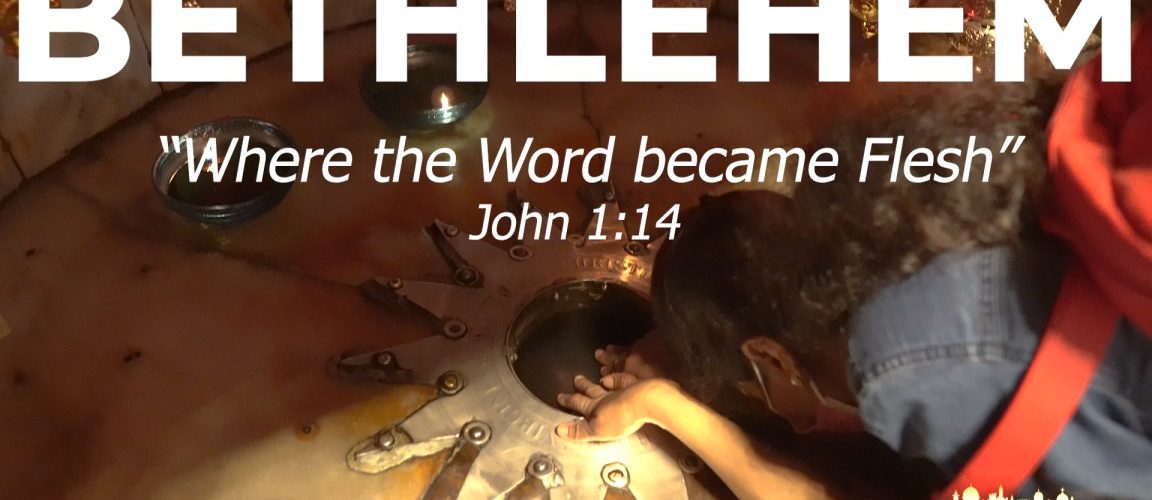BETHLEHEM “Where the Word became Flash”
Today we are visiting the city of Bethlehem. The Hebrew bible tells us King David was anointed in Bethlehem to be king of Israel.
The book of Micha tells us the Messiah will come from Bethlehem:
5:1: “But you, Bethlehem Ephrathah,
though you are small among the clans of Judah,
out of you will come for me,
one who will be ruler over Israel,
whose origins are from of old,
from ancient times.”
Matthew and Luke identify Bethlehem as the birthplace of Jesus.
Now let’s start our tour of Bethlehem.
The Church of the Nativity
The Romans destroyed Bethlehem during the Bar Kokhba revolt in 130 CE.
Right after the Roman empire accepted Christianity as its official religion in 327, Helena, mother of Constantine, commissioned the building of the church of the Nativity in Bethlehem.
The Sumerians destroyed the church in a revolt during the sixth century, but Emperor Justinaina rebuilt it several years later to its current condition.
The church of the Nativity is considered the oldest church in the holy land.
The entrance to the church is through a 1.2-meter high doorway which requires the entering visitor to stoop low in respect for the place where God becomes in the flesh. This is why the entrance is called the “Door of Humility.”
Church of the Nativity’s Angel
Over there, near the ceiling, are mosaics from Constantine’s basilica.
Can you believe they are more than 1500 years old?
One of the angles was discovered only in 2016 by an Italian team of restorers. The hidden angel mosaic was covered by plaster and dirt for almost 1500 years. This angel (number 7th ) points to the grotto where Jesus was born.
The church
The red limestone pillars were quarried locally; many are covered with Crusader paintings of saints.
Since the Greek Orthodox control this church, a golden Iconostasis separates the main altar from the public.
Right to the Iconostasis is the entrance to the Grotto, which is crowded with people waiting to enter.
While waiting, people light candles, and some prepare notes to leave there.
The Grotto
The Gospels do not say Jesus was born in a cave, but references backdated 160 AD tell us that families used to live in primitive houses in front of caves.
When Elena built the first church, she expanded the cave so pilgrims could pray in front of it.
Below the altar is a fourteen-point Silver Star, as a cymbal to the Star of Bethlehem who guided the Magi, which marks the place where Jesus was born. The place where the “Word became Flesh,” as John describes it.
People from all over the world come to touch this place.
In the 19th century, this star disappeared (Stolen), which was one reason for the Crimean War between Russia and the Ottoman Empire, which France and the United Kingdom supported.
“Hic de Virgine Maria Jesus Christus Natus est” (Here Jesus Christ was born to the Virgin Mary)
The Manger
After giving birth, Mary lay down baby Jesus in a manger nearby, which is marked over there.
A marble board covers the original rock shelf to prevent pilgrims from taking pieces of the rock.
The manager’s size matches feeding troughs from the time of Jesus.
You can see the original rock around the manger.
Opposite the manager is a small altar dedicated to the Magi, the 3 Wise Men mentioned in Matthew’s Gospel, as coming from the East (probably Persia) to worship the newborn Jesus.
Church of St. Catherine of Alexandria
The church of St. Catherine of Alexandria is a catholic church where each year, on December 24th, the catholic Mass takes place and is beamed to viewers worldwide.
Catherine of Alexandria was a 4th-century martyr in Egypt.
The status here is of Hironimus, who translated the bible from Hebrew and Greek to Latin – the Volgota.
The Milk Grotto
Our next visit is to the Milk Grotto.
According to tradition, on its way to Egypt to escape Herod’s soldiers, the holy family rested in this cave and Mary breast-feeding Jesus. The cave rock is out of soft white rock, and tradition tells us that when Mary nursed Jesus, a drop of Mary’s milk fell, and as it touched the stone, it turned white.
In 1872 the Franciscans built around the Grotto, the church we see today.
The place is sacred to Christians and Muslims, and women who are trying to conceive visit this place. Some even mixed soft white chalk with their food to become pregnant or increase their milk quantity.
In 2007 a modern chapel dedicated to Mary, the mother of God, was opened, and a tunnel connects it to the Milk Grotto.
Another site where people commemorate Mary Breast-feeding Jesus is at the Monastery of Saint Gerasimos in the Judean desert.
The Shepherds’ Field
Our next and last stop is the Shepherds’ field on the north ridge of Beit Sahur.
According to tradition, this is the field where the angel appears to the shepherds announcing the birth of Jesus.
Archeological findings, as we can see, support the tradition that this place served as a place for shepherds to rest with their sheep and goat.
Here is an entrance to a large cave where groups of pilgrims can rest and connect with traditions about the birth of Jesus: The Manger, The birth, The Star
The Franciscan Church
In the 19th century, the Franciscans built a tent-shaped chapel near the remaining of a 4th-century church. Inside the chapel are wall paintings depicting the angel announcing the shepherds, the shepherds coming to see baby Jesus, and everyone celebrating the birth of the Messiah.
Notice the dog in the first painting as it is nervous, then when he is near baby Jesus, it is calm and full of Joy with all the rest.
That is for today, and until we meet in our next video, let’s live the Jerusalem Experience!


